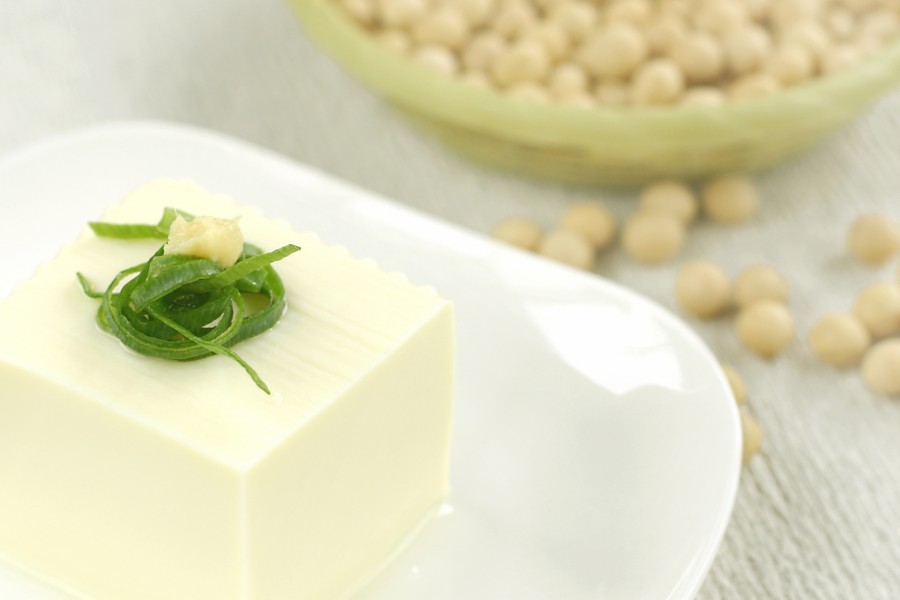Tofu is a food made of soy milk and adding nigari (magnesium chloride) , and its’ pressed into solid white blocks.
Contents:
- The tale of tofu – Making delicious tofu
- Tofu Q&A
- Process of Tofu Making
- How to make fresh tofu?
- Let’s make homemade tofu!
The tale of tofu – Making delicious tofu
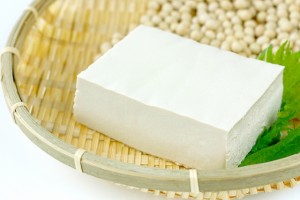 Tofu can be considered the most vital ingredient that characterizes Japanese dining. Japanese people have been eating tofu since the Nara period (710-794 CE), and until this day the fundamental method of making tofu- extracting soy milk from soy and adding nigari (magnesium chloride) to harden-is still the same. For the Japanese community living in America, it was not easy to find delicious tofu until just a few years ago. However, with the rising popularity for Japanese food, as well as the reputation for being healthy and effective for dieting, today, fresh tofu is finally available even in American supermarkets. Tofu has been an important part of the Japanese diet for many years. It is a true blessing to be able to enjoy the same traditional tastes of tofu, even while an ocean away from Japan.
Tofu can be considered the most vital ingredient that characterizes Japanese dining. Japanese people have been eating tofu since the Nara period (710-794 CE), and until this day the fundamental method of making tofu- extracting soy milk from soy and adding nigari (magnesium chloride) to harden-is still the same. For the Japanese community living in America, it was not easy to find delicious tofu until just a few years ago. However, with the rising popularity for Japanese food, as well as the reputation for being healthy and effective for dieting, today, fresh tofu is finally available even in American supermarkets. Tofu has been an important part of the Japanese diet for many years. It is a true blessing to be able to enjoy the same traditional tastes of tofu, even while an ocean away from Japan.
The tofu factory here in America is installed with the latest technology. Everyday tofu is manufactured under strict hygiene management in order to provide customers with safe, delicious tofu. Why don’t we take a look at the factory’s step-by-step process to learn the ins-and-outs of how tofu is made?
Tofu Q&A
Q1. How long is the tofu good for?
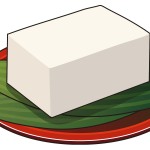 House Tofu lasts for 65 days, provided that it is kept refrigerated at adequate temperatures. Generally, tofu from smaller neighborhood tofu shops will last 3 to 4 days.
House Tofu lasts for 65 days, provided that it is kept refrigerated at adequate temperatures. Generally, tofu from smaller neighborhood tofu shops will last 3 to 4 days.
Q2. Does the tofu sold in America contain a special kind of additive?
Chemical additives such as preservatives and food colorings are never used.
Q3. Why does the tofu sold in America have later expiration dates?
Tofu is rich in nutrients and very moist, which makes the perfect environment for bacterial growth. Other than heat pasteurization, strict quality control is practiced during each manufacturing procedure, and sanitary conditions are kept at high standards throughout the entire process. By doing this, the product’s fresh flavor is preserved for a longer period of time and the expiration date can be lengthened.
Q4. What methods are used for pasteurization?
First, after the soy is crushed, it is heated to over 100°C (212°F), which kills the majority of bacteria. Next, after it is packaged, pasteurization is performed. In order to kill the heat-resistant bacteria that cannot grow under low temperatures, House Foods have installed a boil-cool pasteurizing machine. (This continuously heats the tofu, followed by immediately cooling it.) In this way, any growth of bacteria after pasteurization is suppressed.
Q5. Under what circumstance does the flavor of tofu degrade?
If the temperatures rise during storage, it is possible for heat-resistant bacteria to begin growing. Generally, these types of bacteria are not dangerous. However, because it can cause an increase in acidity and a sour taste, the tofu should be thrown out.
Q6. What is the best method for its preservation?
After buying tofu at a store, make sure that its temperature does not rise. Keep it in a cooler bag or ice chest, or next to frozen foods. Do not leave it in the car for too long as temperatures are likely to rise. Try to put it in the refrigerator as soon as possible. (Tofu cannot be kept frozen)
Q7. What are some points to make note of when handling tofu?
You should use all the tofu after it is opened. However, left overs can be stored with water in a container covered with a lid or wrap to prevent the tofu from drying out. Keep it refrigerated. It is recommended that you finish it as soon as possible.
Tofu is a processed food, but very delicate in the same way as fresh foods. As long as preservation methods (temperatures) are properly followed, its taste will stay fresh and delicious until its expiration date.
Tofu comes in a variety of different firmnesses to match different dishes and styles of cooking. Let’s incorporate more tofu into our daily diet and start living healthier lives!!
Process of Tofu Making
Step 1: Soybean Selection
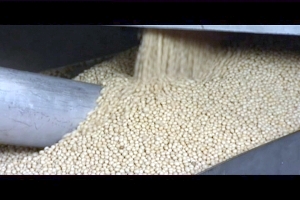 The first step is acquiring the soybeans. House Foods only use Non-GMO soybeans grown in the U.S. Each batch of soybeans they receive is tested by our Quality Control department, and if the GMO contamination is detected, the batch of soybeans will be rejected. They also look for soybeans with the highest protein content, as they are the best for making tofu.
The first step is acquiring the soybeans. House Foods only use Non-GMO soybeans grown in the U.S. Each batch of soybeans they receive is tested by our Quality Control department, and if the GMO contamination is detected, the batch of soybeans will be rejected. They also look for soybeans with the highest protein content, as they are the best for making tofu.
Step 2: Soaking
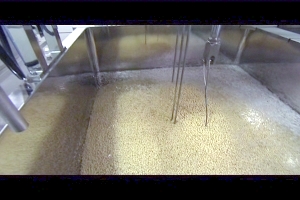 Those beans that make it through our acquisition process go on to our soaking round and spend the next 10 to 13 hours in a tank filled with water.
Those beans that make it through our acquisition process go on to our soaking round and spend the next 10 to 13 hours in a tank filled with water.
Step 3: Grinding/Filtration (possible to combine)
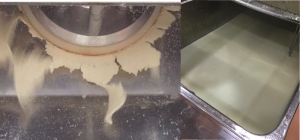 After a prescribed amount of water is added to the soybeans, they are ground to a slurry (a thin mixture of an insoluble substance) in order to make the extraction of protein easy, then are heated. The heating process eliminates soybean odor while pasteurizing the slurry and allowing for a better coagulation of proteins. In the filtration phase, the solid matter and soy pulp (okara) are separated, resulting in smooth soy milk.
After a prescribed amount of water is added to the soybeans, they are ground to a slurry (a thin mixture of an insoluble substance) in order to make the extraction of protein easy, then are heated. The heating process eliminates soybean odor while pasteurizing the slurry and allowing for a better coagulation of proteins. In the filtration phase, the solid matter and soy pulp (okara) are separated, resulting in smooth soy milk.
Step 4: Coagulation
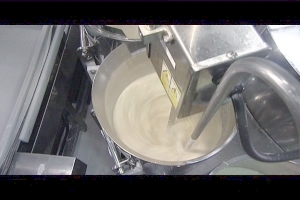 The soy milk must then begin a transformation during the coagulation phase. It becomes a thickened mass when mixed with calcium salt and other coagulants, resulting in the coagulation of soy milk into curd form.
The soy milk must then begin a transformation during the coagulation phase. It becomes a thickened mass when mixed with calcium salt and other coagulants, resulting in the coagulation of soy milk into curd form.
Step 5: Forming
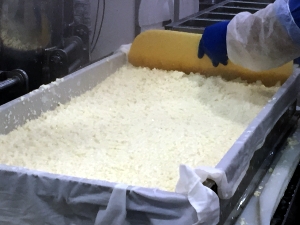 The tofu curds are then broken up into a cloth-lined box.
The tofu curds are then broken up into a cloth-lined box.
Step 6: Pressing
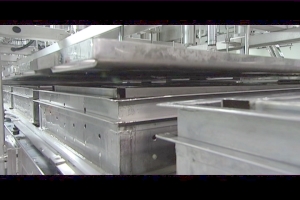 The box is then pressed to eliminate excess water. The harder and the longer the tofu curds are pressed, the firmer they get, resulting in varying tofu firmness levels. Soft (silken) tofu is made by coagulating thicker soy milk, not by pressing.
The box is then pressed to eliminate excess water. The harder and the longer the tofu curds are pressed, the firmer they get, resulting in varying tofu firmness levels. Soft (silken) tofu is made by coagulating thicker soy milk, not by pressing.
Step 7: Cutting
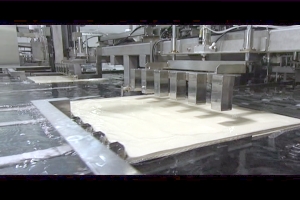 After being pressed, the tofu box is then pushed through a large machine to be cut into perfect sized rectangles.
After being pressed, the tofu box is then pushed through a large machine to be cut into perfect sized rectangles.
Step 8: Packaging/Labeling
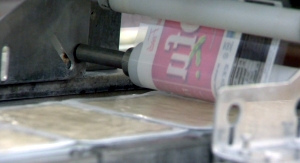 Once the tofu is cut, it is packed into convenient packages filled with water. It is then thermally sealed with the House Foods label.
Once the tofu is cut, it is packed into convenient packages filled with water. It is then thermally sealed with the House Foods label.
Step 9: Pasteurizing
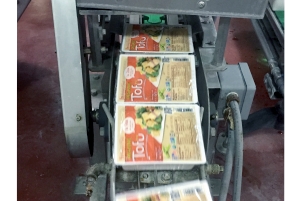 After the tofu is packaged and labeled, it is pasteurized in a boil-cool pasteurizing machine. It continuously heats the tofu, followed by an immediate cooling process. This ensures that our tofu stays fresher for a longer period of time.
After the tofu is packaged and labeled, it is pasteurized in a boil-cool pasteurizing machine. It continuously heats the tofu, followed by an immediate cooling process. This ensures that our tofu stays fresher for a longer period of time.
Photos and text by House Foods America
How to make fresh tofu?
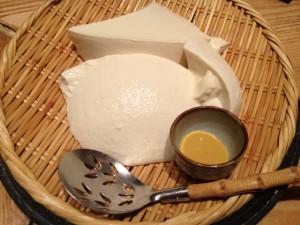 Easy to make, absolutely delicious!
Easy to make, absolutely delicious!
Soybeans are rich in nutrients for maintaining your health, including isoflavone, saponin and lecithin. Soybeans are believed to prevent all kinds of modem ailments and adult diseases. They lower the blood cholesterol level and limit the formation of the lipid proxide, thus preventing blood clots and hardening of the arteries. They also improve intestinal health by preventing indigestion, constipation and the resultant skin problems. What’s more, the antioxidants in soybeans can suppress cancer development and inhibit calcium efflux, thus helping prevent heart disease, osteoporosis and menopausal symptoms. You can have a perfectly balanced meal by eating soybeans with seafood, grains and fresh vegetables containing unsaturated fat. As you may know, soybeans have been a staple food for many Japanese people who are over 100 years old today.
By acquiring a few techniques, you can make unbelievably delicious tofu in your own home. All you’ll need is Nijiya Soy Milk (original), which is made of organic soybeans, and natural nigari (bitter) liquid.
Homemade tofu has exceptional flavor, so it’s perfect for your guests. So, why not give it a try?
Let’s make homemade tofu with soy milk!
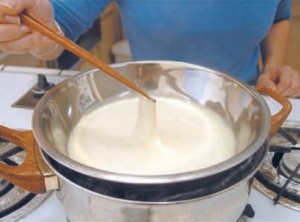 You can make incredibly delicious tofu and yuba (bean curd skin) using Nijiya Soy Milk (original), made of organic soybeans, and natural nigari. You might find it a bit hard at first, but once you get the hang of it, it will be easy. We’re certain you’ll be hooked on this new taste sensation!
You can make incredibly delicious tofu and yuba (bean curd skin) using Nijiya Soy Milk (original), made of organic soybeans, and natural nigari. You might find it a bit hard at first, but once you get the hang of it, it will be easy. We’re certain you’ll be hooked on this new taste sensation!
- A point to remember when making tofu or yuba is that the soy milk must never boil. Also, if you want to savor the delicate flavor of tofu, we suggest eating the tofu as an appetizer using less seasoning.
- Cooking time varies according to the type of microwave you use. Consider the cooking time directed in the recipe only as a guide. A secret to successful tofu/yuba making is to set the timer for less than directed at first, and then extend the cooking time little by little as you check for doneness.
Homemade Momen Tofu Recipe
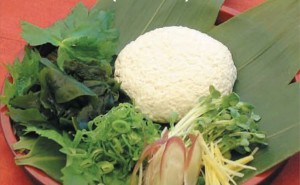
Ingredients (Serves 2)
30 oz Nijiya Soy Milk (original)
3 to 4 tsp. Natural Nigari liquid
Cooking Directions
- In a saucepan, heat the soy milk over low heat till it reaches a temperature of 175°F.
- Remove from heat and add nigari, stirring lightly with a spoon. (The soy milk will start to coagulate.)
- Line a strainer with cotton cloth (or paper towel) and pour in the soy milk mixture. Let the extra liquid drain.
- Carefully remove the cloth from the strainer and take out the coagulated tofu. Serve with the desired condiment and/or sauce.
